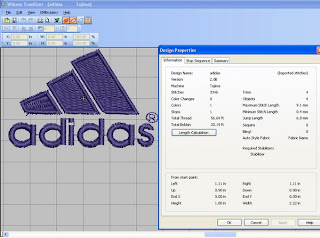What form of artwork do you prefer? Embroidery designs come in a lot of different file formats, after you have bought your private embroidery machine, sooner or later, you're going to want to create an embroidery project that requires something different. The Internet is the most common place to find or download embroidery designs. You will need an appropriate software in order to transfer the design files from your computer to the embroidery machine.
There are many websites where you can purchase embroidery designs and download them directly to your computer. Most sites have free designs you can try. The computer processes the artwork from any embroidery files that the machine can understand. The good news is you can be embroidered any design files format, but first it needs to be converted into a format that is accepted and readable by the embroidery machine. That conversion process is called "digitizing".
After few years spent on exploration, a good embroidery file format includes a vector description of each design part and attaches abstract stitching information to that object. The reason for this is because any artwork file provided for embroidery has to go through an additional process called digitizing. This conversion process takes the artwork from a format for the computer and turns it into a file that the embroidery machine can read and then use as instruction for the stitching, the digitized file tells the embroidery machine where, how and which colors to use while stitching. Unfortunately the digitizing process itself is often a very time consuming thing. For that reason it is best to place your order and download the embroidery design file format that matches to your machine.
The most popular rather machine-specific format seems to be *.PES (Brother) since it also includes worker information. Less powerful formats are directly stitch-based. Another embroidery formats seem to be DST and EXP also popular. The DST by Tajima is the universal embroidery file format, it is mean, DST files can be read by all embroidery machines, but these are not necessarily the best.
DST's are stitches only and reshaping is not always possible, because it's limited and editing functions can be poor, plus resizing of a DST is very dangerous as it will simply bunch the stitches and not reprocess the stitches like it will in a EMB file. EMB format is vector-based artwork, this files can be transformed without deforming stitches.
Wilcom embroidery software has the technology where it attempts to re-trace a .DST file and turn it into an outline file, but it will not give you as good quality as if it was an original .EMB file. Keep your file in .EMB though as this is a true embroidery object file. If possible ask your design supplier for a .EMB file. It will save you a lot of time and money when editing is concerned.
You can convert your *.DST file extension if you have the right software. Wilcom Truesizer e2 software able to reading or writing of DST files. You need to download and learn your free wilcom TrueSizer software. The golden rule is always keep the machine embroidery design in .EMB file and only make a stitch file such as .DST to send to the machine. Any editing should be done on the .EMB file and then re-saved embroidery design as a .DST only if needed.

TO Get a copy for wilcom ES 9 Software
ReplyDeleteA great helpful content on the different format of embroidery digitizing files. I just found the way to convert jpg to dst. Thank you very much.
ReplyDelete